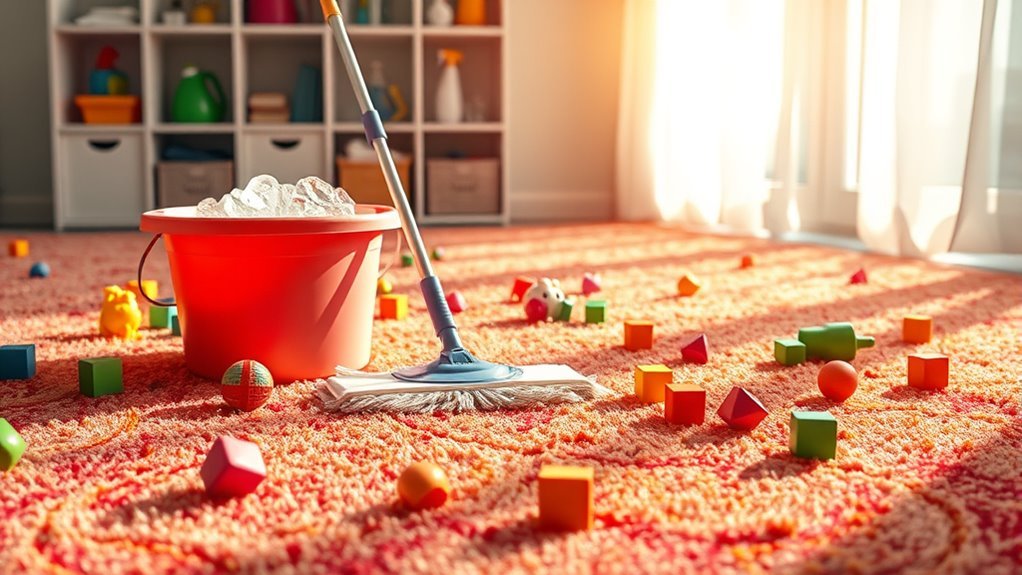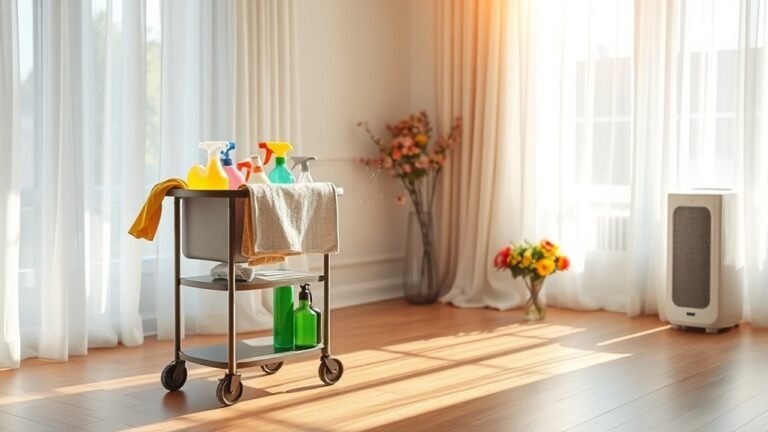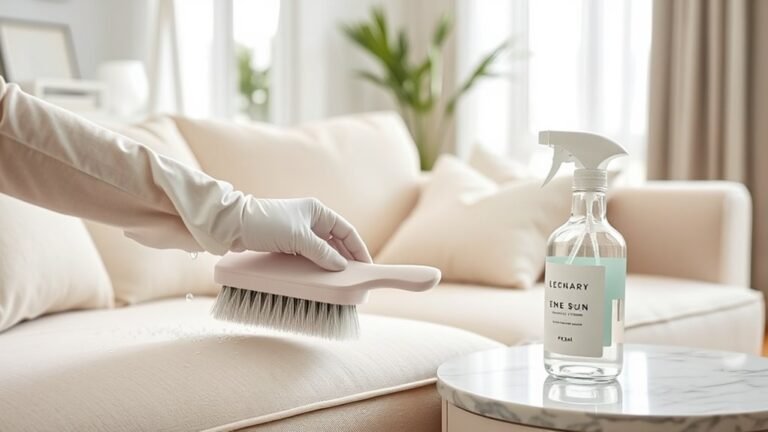Deep Cleaning Guide for Toys Flooring
You’ll want to clean toys and play area floors regularly to keep kids healthy and safe. Use mild soap and water for plastic toys, spot clean fabrics, and gently wipe wooden toys without soaking. For floors, vacuum or sweep daily, mop hardwood or laminate carefully, and deep clean carpets often. Encourage kids’ hand hygiene and tidy up toys after play. Following these tips helps prevent germs and mess. Keep going to discover easy, safe cleaning routines and tricks.
Importance of Regular Deep Cleaning for Play Areas
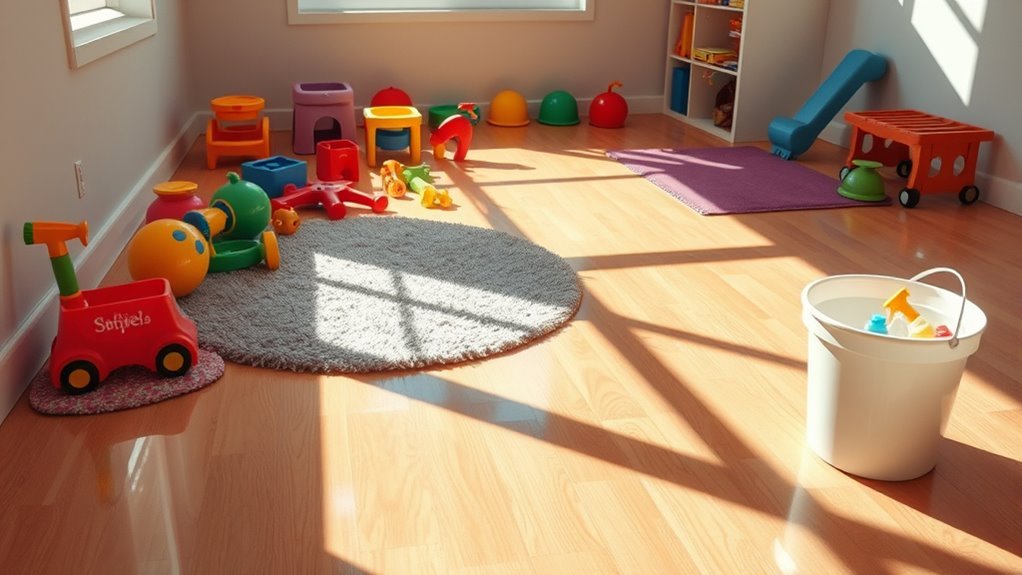
A clean play area isn’t just about appearances—it’s vital for your child’s health and safety. When you prioritize play area hygiene, you create a safe environment where your little one can explore freely without unnecessary risks. Regular deep cleaning removes hidden germs, dust, and allergens that could cause illness or discomfort. It also helps maintain toy safety by preventing buildup that can damage toys or harbor bacteria. By staying on top of cleaning, you guarantee that every play session is worry-free, allowing your child to enjoy their space fully. Embracing this routine gives you peace of mind while supporting your child’s natural curiosity and freedom to play, learn, and grow in a healthy, safe setting.
Identifying Different Types of Toys and Their Cleaning Needs
You’ll want to recognize the materials your toys are made from since each type needs different care. Knowing how often to clean them and which methods are safe will keep toys both clean and intact. Let’s explore the best ways to handle common toy materials and their cleaning schedules.
Types of Toy Materials
Understanding the materials toys are made from is key to cleaning them effectively without causing damage. Plastic toys are durable and usually waterproof, so you can use mild soap and water freely. Rubber toys are flexible but sensitive to harsh chemicals, so gentle cleaning is best. Fabric toys, however, often need spot cleaning or machine washing on a delicate cycle.
| Material | Cleaning Method | Notes |
|---|---|---|
| Plastic Toys | Soap and water | Waterproof, easy to clean |
| Rubber Toys | Mild soap, soft cloth | Avoid harsh chemicals |
| Fabric Toys | Spot clean or machine wash | Delicate, may dry slowly |
Knowing these differences lets you clean toys safely, maintaining their look and your freedom to enjoy them.
Cleaning Frequency Recommendations
Many toys need cleaning more often than you might expect, depending on how they’re used and what they’re made of. For example, soft toys that kids hug daily require a more frequent cleaning schedule, while plastic or wooden toys might not need deep cleaning as often unless they’re shared or visibly dirty. You’ll want to assess each toy’s material and usage to decide how often they need attention. High-touch toys like building blocks or action figures benefit from weekly wipe-downs, with a monthly deep cleaning to keep germs at bay. For plush toys, a biweekly deep cleaning might be necessary, especially if they’re often in your child’s bed or play area. Tailoring your cleaning schedule this way keeps toys safe and fresh, letting your little ones play freely.
Safe Cleaning Methods
Different types of toys require different cleaning methods to keep them safe and in good condition. When you choose eco friendly products and child safe materials, you protect your little one and the planet. Here’s a quick guide to help you match toys with the right cleaning approach:
| Toy Type | Cleaning Method |
|---|---|
| Plastic Toys | Wipe with mild soap & water |
| Plush Toys | Machine wash on gentle cycle |
| Wooden Toys | Wipe with damp cloth, avoid soaking |
| Electronic Toys | Use a lightly damp cloth, no soaking |
| Bath Toys | Soak in vinegar solution, air dry fully |
Safe Cleaning Solutions for Children’s Toys
When it comes to cleaning your child’s toys, choosing safe solutions is vital to protect their health. You want to avoid harsh chemicals that can linger and cause harm. Instead, consider eco friendly alternatives that are gentle yet effective. Homemade cleaners using simple ingredients like vinegar, baking soda, and mild soap can do wonders without risking your child’s safety. These options not only reduce exposure to toxins but also give you the freedom to know exactly what’s being used on toys your little one handles daily. Plus, they’re budget-friendly and easy to make at home. By opting for these safe cleaning solutions, you guarantee a healthier play environment while staying true to your values of natural, sustainable living.
Step-by-Step Guide to Cleaning Plastic and Rubber Toys
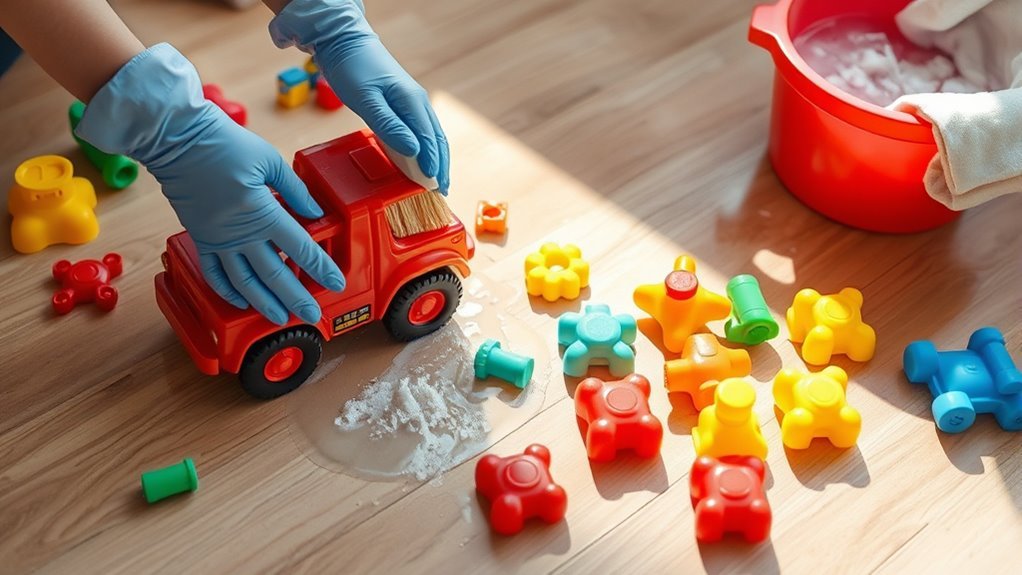
When cleaning plastic and rubber toys, choosing the right solution is key to keeping them safe and effective. You’ll want to follow a few simple steps to guarantee thorough cleaning, proper drying, and safe storage. Let’s walk through the process to make it easy for you.
Cleaning Solutions Overview
Although cleaning plastic and rubber toys might seem straightforward, using the right solutions guarantees they’re thoroughly sanitized without damage. You’ll want to pick eco friendly products that are gentle yet effective, avoiding harsh chemicals that can wear down toys or irritate skin. Homemade solutions, like a mix of vinegar and water or baking soda paste, offer a natural way to disinfect while keeping you free from toxins. These options not only protect the toys but also give you peace of mind knowing your cleaning routine aligns with your values. When choosing or mixing your cleaning agents, always consider the toy’s material and manufacturer instructions to keep everything safe and fresh. This approach assures your toys stay clean and ready for endless play.
Drying and Storage Tips
Several key steps guarantee your plastic and rubber toys dry thoroughly and stay in good condition. Proper drying techniques prevent mold and damage, while smart storage solutions keep them ready for fun. Here’s how you can handle drying and storage efficiently:
- Air-dry toys completely on a clean towel in a well-ventilated area; avoid direct sunlight to prevent fading or warping.
- Use a soft cloth to remove excess water from small crevices, speeding up drying and stopping moisture buildup.
- Store toys in breathable containers or mesh bags to maintain airflow, protecting them from dust and dampness while letting you access them freely.
Following these steps guarantees your toys stay fresh and intact, giving you the freedom to enjoy them anytime without worry.
Best Practices for Cleaning Wooden Toys
Since wooden toys require gentle care to maintain their natural finish, you’ll want to avoid harsh chemicals and excessive moisture. For effective wooden toy care, start by wiping toys with a soft cloth dampened with a mild soap and water solution. Be sure not to soak the wood; instead, quickly dry each piece with a clean towel to prevent warping or cracking. To preserve natural finishes, you can occasionally rub in a food-safe oil, like mineral or coconut oil, which nourishes the wood and keeps it looking vibrant. Avoid abrasive scrubbing or machine washing, as these can damage the surface. By treating your wooden toys with this gentle routine, you’ll enjoy their timeless beauty and durability, all while giving your little ones safe, clean playthings that last.
Effective Methods for Deep Cleaning Carpeted Play Floors
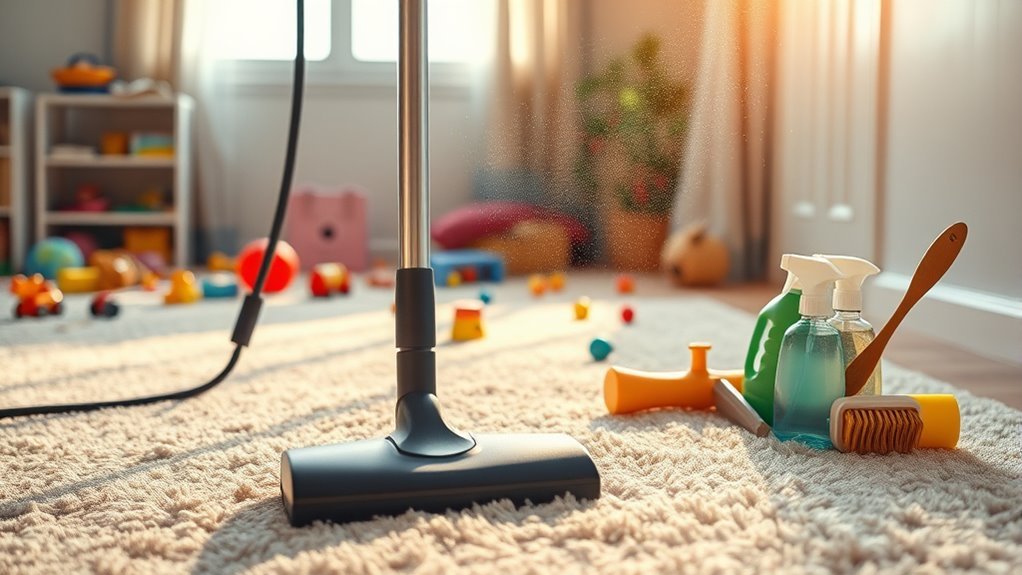
When you want to keep carpeted play floors hygienic and safe for your kids, deep cleaning is essential. You can’t just rely on surface vacuuming; thorough carpet cleaning removes hidden dirt and allergens, ensuring a healthier environment. Here’s how to do it effectively:
- Pre-treat stains: Use a kid-safe carpet cleaner on spots before deep cleaning to break down grime.
- Use a steam cleaner: This method penetrates deep into the fibers, killing germs and lifting dirt without harsh chemicals.
- Dry thoroughly: After cleaning, ventilate the room or use fans to prevent mold and mildew growth on your play floor.
Maintaining and Sanitizing Hardwood and Laminate Flooring
Although hardwood and laminate floors are durable, they need regular maintenance to stay clean and sanitary, especially in play areas. For effective hardwood care, sweep or vacuum daily to remove dirt and debris that can scratch the surface. Use a damp mop with a cleaner designed specifically for hardwood—avoid excess water to prevent warping. When it comes to laminate maintenance, stick to dry or slightly damp mopping to preserve the protective layer. Avoid harsh chemicals that can dull the finish. To sanitize both, use a gentle disinfectant safe for wood and laminate surfaces, ensuring it doesn’t leave residue or damage the floor. Keeping up with these simple steps lets you enjoy clean, safe floors without feeling tied down by complicated routines.
Tips for Preventing Dirt and Germ Build-Up in Play Areas
To keep play areas clean and healthy, you’ll want to tackle dirt and germs before they have a chance to build up. Prioritizing play area hygiene makes the space safer and more enjoyable for everyone. Here are three essential tips to help you stay ahead:
Tackling dirt and germs early keeps play areas safe, clean, and fun for everyone.
- Regular Cleaning Routine: Set a schedule to vacuum and mop floors, wiping down toys and surfaces to remove dirt and bacteria effectively.
- Effective Toy Organization: Use bins or shelves to keep toys off the floor, reducing dust and germ accumulation. Encourage kids to put toys away after playtime.
- Hand Hygiene Habits: Teach kids to wash hands before and after play, minimizing the transfer of germs in the play area.
These simple steps give you freedom from constant mess and promote a healthier environment.
Frequently Asked Questions
How Often Should Toys Be Deep Cleaned in Daycare Centers?
Like tending a garden where every bloom matters, you should follow frequency guidelines to keep toys safe and clean in daycare centers. You’ll want to set cleaning schedules that balance thoroughness with practicality, typically deep cleaning toys weekly, or more often if heavily used. This routine helps prevent the spread of germs, giving kids the freedom to explore and play without worry, ensuring a healthy, joyful environment for all.
Can UV Light Be Used to Sanitize Toys and Flooring?
You can use UV sanitation to sanitize toys and flooring, but you should know its effectiveness varies. UV light works best on smooth surfaces and exposed areas, killing many germs without chemicals. However, it might not reach hidden dirt or shadows, so it’s not a total replacement for regular cleaning. If you want freedom from harsh chemicals, combining UV with routine cleaning can keep your space safer and fresher.
What Are the Best Storage Solutions to Keep Toys Clean Longer?
Think of your toys like a garden; without the right care, they wilt and get messy. Using clear storage containers lets you see what’s inside while keeping dust out, making toy organization tips a breeze to follow. You’ll find freedom in a clutter-free space, where toys stay clean longer and kids can play freely without stepping on scattered pieces. Keep it simple, stylish, and functional for lasting order.
How to Handle Mold Growth on Toys and Flooring?
If you spot mold on toys or flooring, don’t stress. Start by removing the affected items and cleaning them with a mold prevention cleaning solution, like diluted vinegar or a mild bleach mix. Make sure to dry everything thoroughly to stop mold from coming back. Keep your space well-ventilated and manage humidity levels to maintain freedom from mold growth. Regular cleaning and quick action will help you enjoy a fresh, mold-free environment.
Are There Eco-Friendly Toy Cleaning Services Available?
Yes, you can find eco-friendly toy cleaning services that use gentle, non-toxic products and sustainable cleaning techniques. These services let you keep your kids’ playthings spotless without harmful chemicals, giving you peace of mind and freedom from worrying about harsh residues. By choosing eco-friendly products and methods, you’re not only protecting your family’s health but also supporting a cleaner planet, so you can enjoy a safe, fresh environment for your little ones.
